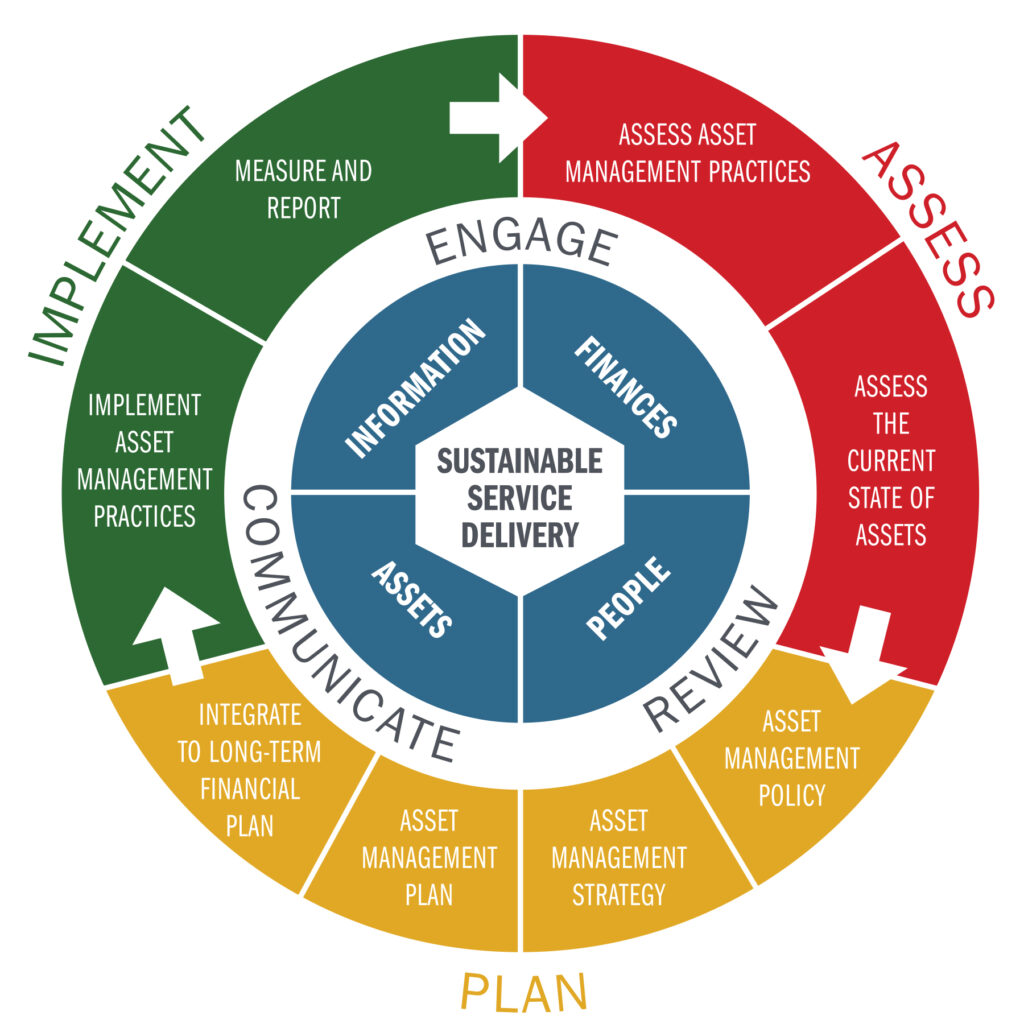Through the AM competencies discussed in the last few pages, you will be starting to improve your AM processes and practices. But it’s important to formalize these changes and ‘lock them in’ to your organization, so that things don’t slip back to the old way of working. Putting in place policy, strategy and governance components helps solidify asset management within the organization. These components are referred to as Strategic Asset Management elements.
Integrating with Sustainability
Some municipalities are including “Natural Assets” within their AM practices, and opting to manage things like land, drainage channels, rivers and aquifers, alongside their more traditional infrastructure assets. They define this within the scope of their AM Policy to make it clear to staff in the organization.
Policy
The AM Policy outlines why asset management is important to the organization, what services and assets are to be considered in scope for AM activities, and the principle statements for implementing AM within the organization. Having the AM Policy signed off by top management and approved by council sends a very clear message to the organization that AM is important and what needs to be considered when implementing it. Make sure you share and communicate your AM Policy with your organization as part of your change management effort.

The principle statements in the AM Policy are of utmost importance as they define the approach to asset management that staff throughout the organization are expected to follow.
“The level of effort isn’t in writing the AM Policy, but in spending time on communicating with the Management Team and Council on what needs to be in the AM Policy and why.”
Patrick Brisson, AM Program Manager, City of Ottawa, Ont.
Strategy and Framework
You need to start documenting the HOW. How are you going to enable the principles you’ve outlined in your policy? What are you doing to define your service performance objectives? How are you actually going to make asset management happen in your organization?
“An Asset Management Strategy defines the municipality’s asset management objectives and strategies on achieving the Policy requirements. The strategy is focused on improving the municipality’s asset management practices.”
AM Primer
The AM Strategy – sometimes referred to as a Strategic Asset Management Plan (SAMP) – is an important tool in developing your management system for asset management. It builds a clear line of sight between your organizational objectives and your asset management efforts, demonstrating how AM will help you to meet your goals. It describes the key asset management processes, tools, and documents that your staff will use to implement your AM policy. And it shows what you are doing and the resources you are allocating to improving your AM practices. The AM Strategy document is a good place to include your Asset Management Roadmap that captures your five-year plan on how you are working to improve your asset management processes and improve upon the gaps in your practices.
More information on developing an AM policy and strategy can be found here.
“Don’t underestimate your AM Strategy, it can be a significant document. The AM Policy is more conceptual, and the AM Strategy is HOW you put things into practice”
Fernando Smith-Avendano, City of Airdrie, Alta
Frameworks are often illustrated graphically – a great way of presenting the different components and elements of asset management that you are working on and how they connect. Asset Management British Columbia (AMBC) has developed a framework that establishes a high-level, systematic approach that supports local governments in moving toward service, asset and financial sustainability through an asset management process. AMBC has produced a detailed document that accompanies the graphic and explains how a municipality can work through each process.

ISO 55000 Standard
As asset management globally has grown in recent decades, it was inevitable that a standard would emerge. In 2014, ISO 55000 was published by the International Organization for Standardization (ISO). ISO 55000 defines what the management system for asset management is, and by management system, they mean your formalized approach to asset management. What processes, resources, IT systems, and other resources do you use to manage your asset management efforts?
An asset can be anything that delivers value to your organization. In the context of this booklet, we are focusing on assets being physical infrastructure, but the ISO 55000 standard is designed to apply to a wide range of ‘assets’ to your organization.
It’s important to note, the standard does not tell you HOW to do asset management, it just tells you WHAT you need to cover. And this WHAT is a checklist that an auditor would use to validate your organization’s performance. For the municipal world, ISO 55000 certification is not crucial, but it does articulate good asset management practice and is a very useful tool and checklist to align our efforts with.
Governance
It is important to think about who is accountable for asset management in your organization. Who is making sure that this is happening, and that the right people are responsible for the right parts of your asset management journey? This takes time to get right and varies by individual organizations, as there will be existing structures and accountabilities in your organization that you will need to align with.

In the Initial Steps section we suggested forming an AM Committee – they can be a very useful group to govern and steer your asset management efforts across your organization.
The People and Leadership competency also plays a significant role here as having a Senior Sponsor in place is an important part of your AM Governance.
Measurement and Monitoring
It might take years to measure financial returns, but within a short time you can measure improvements in any of the asset management competencies and start to see how some of the more significant benefits will be realized. Use a Gap Assessment tool to measure your progress along your journey.

Do I need to improve all components at the same time, and to the same level of maturity?
Absolutely not. Make targeted improvements to specific components as part of your Asset Management Roadmap, one component at a time is totally fine. As an organization you might decide you don’t need to be top of the class in every competency. Different things are appropriate for different organizations.

